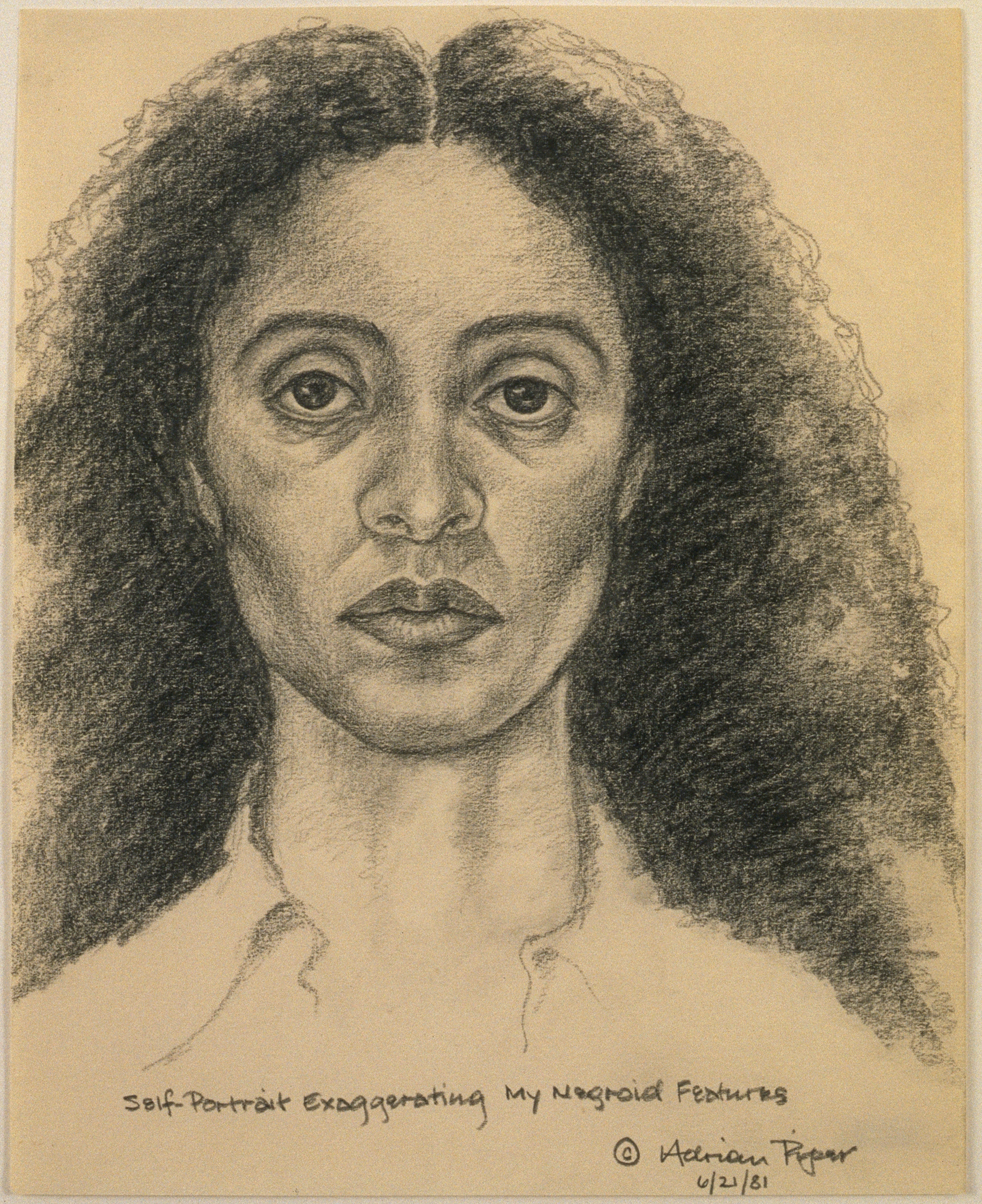Adrian Piper’s artistic statements reject a moralizing approach. “I try for simplicity, not simplification. I don’t want to make prescriptions about what people should do. I just want to penetrate the layers of illusion and self-deception as far as possible and to do it clearly without losing any of the mind-bending complexity of the issues.” Irreducible complexity is fertile soil for the artist, who is currently the subject of a retrospective at the Museum of Modern Art that surveys a wide body of work: from early sculptures and drawings redolent of 1960s Minimalist aesthetics, to early performance pieces that explore metaphysical concerns and grapple with race, femininity, and sexuality. The exhibition closes with works that confront, head-on, the persistent force of white supremacy in America. Throughout, visitors are privy to a mind at work, one that rigorously tests its ability to communicate personal meditations on the impacts of structural violence. Piper’s aesthetic experiments are also spaces to consider the potential to act or react to moral injustice. Yet, rather than attempt to convince viewers of ideological positions, Piper foregrounds affective reactions that, in turn, prompt reflexive thought. Whether or not these manifest in concrete action, the force of Piper’s art is undiminished.
Forty years prior to this current exhibition, MoMA held a landmark survey of Conceptual Art titled Information, which included several pieces that required viewers’ activation. Among these participatory works was Adrian Piper’s Concept #7 (1970), in which the artist presented a notebook and pen with a text panel that encouraged visitors to record their response to a “situation,” given as a prompt. Inspired by the political events of 1970, including the invasion of Cambodia and the violence perpetrated against antiwar protestors at American universities, Concept #7 was Piper’s attempt to do away with self-contained art that referred only to “the stability of easily-accepted functional identities which no longer exist.” Choosing instead to consider the stakes of her own position as a woman, a black person, and an artist, Adrian Piper shifted her Minimalist-influenced practice to Conceptual works that zeroed in on the critical boundaries between aesthetics and ethics. Injecting the white-male dominated Conceptual sphere with a much-needed inward look on race and sexuality, the artist’s works reflect on how individual, personalized conceptions of ethical behavior engender hegemonic values.

Adrian Piper, “Self-Portrait Exaggerating My Negroid Features,” 1981. The Eileen Harris Norton Collection © Adrian Piper Research Archive Foundation Berlin.
Consider, for instance, the installation Aspects of the Liberal Dilemma (1978), a mixed medium installation in which viewers enter a darkened room containing a single black-and-white photograph of black men, installed behind Plexiglas. Through an audio recording, Piper poses a series of questions: What’s the correlation between what you’re seeing and what you’re hearing? Are you being preached to – again? In this Socratic fashion, we are able to recognize that the formal and symbolic dimensions of the work are only activated through the viewer’s intervention. Piper highlights this age-old koan of installation art not to nod to art history for her own sake, but to emphasize the importance of a subject’s positionality. Are we indeed being preached to? Piper leaves the questions unanswered, suggesting that her goal is interrogation, rather than proselytization. In Four Intruders Plus Alarm Systems (1980), she constructs a similar inquisitive environment. Like Aspects of the Liberal Dilemma, the work resonates on the level of personal responsibility and individual morality, this time because of its voluntary nature: a guard ensures that only one person may enter at a time, at their will. Four Intruders, like many of Piper’s works, depends on the viewer’s willingness to cooperate: invitations to act must be accepted.
Liberal society, with all its politesse, is only possible through violence enacted on black lives. Piper addresses the institutional and societal structures that are complicit in racism, xenophobia, and sexism. In these gestures, she is more direct: for the series Vanilla Nightmares (1986), the artist renders haunting, spectral charcoal-and-oil crayon drawings of black bodies – fornicating, being choked, splaying nude – on the pages of the New York Times. Wall-texts refer to the Euro-American “fantasies and fears” of African-Americans, elucidated in the drawings, which underwrite this ongoing violence. In the decade-long work Everything (2003-13), Piper displays a series of photographs with faces erased and replaced by the phrase, “Everything will be taken away.” Another series of photographs of Medgar Evers, Robert F. Kennedy, and Dr. Martin Luther King Jr. are scored with the same line. This juxtaposition – of iconoclasm and iconography – at once unsettles and reassures: everything will in fact be taken away, including, perhaps, the gnawing recognition that history needn’t produce martyrs for our moral benefit.

Adrian Piper, “Everything #2.8,” 2003. Private Collection. © Adrian Piper Research Archive Foundation Berlin.
The exhibition’s chronological nature might be seen as implying that Piper’s work became more political or subversive over time. But this type of reductionist reading fails to acknowledge the power of performances like Mythic Being (1973-75), in which Piper assumed a male alter-ego dressed in dark sunglasses and an Afro. This Mythic Being appeared in public performances and was immortalized in a series of newspaper advertisements in the Village Voice with phrases in speech bubbles drawn by Piper: “I embody everything you most hate and fear.” Like the later Vanilla Nightmares, the work exemplifies Piper’s desire to dig deep into the individual and social psyche – to prod viewers to question their visceral responses more deeply. Piper asks viewers to sit with these emotional reactions as a means to show how they become weaponized by institutional racism and bigotry. As in her other works, she demonstrates a desire to connect individual fears and anxieties into larger questions of power.
And yet, individual actions may be the path to collective change – if we want it. The exhibition closes with The Probable Trust Registry: The Rules of the Game #1-3 (2013), where, at three desks staffed by attendants at computers, willing participants can sign off on a contract adhering to a specific life motto. These mottos are simple declarative statements: “I will always be too expensive to buy,” “I will always mean what I say,” “I will always do what I say I am going to do.” I lingered, along with a few other museumgoers, before committing to one of them: I didn’t want to fail, to somehow disappoint. Piper’s invitation to commit to the rules of this game elevates the precise moments before the invitation is accepted – before thought becomes action, and will becomes gesture.
























2 Comments